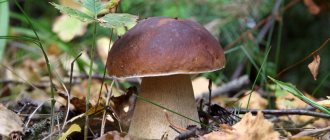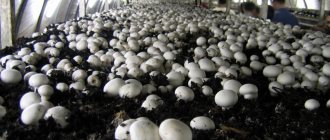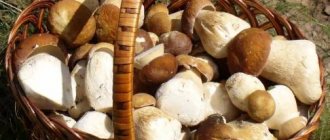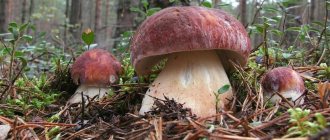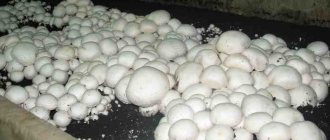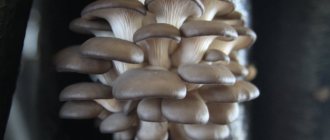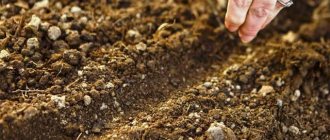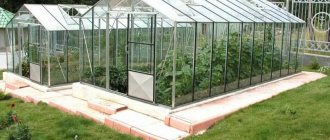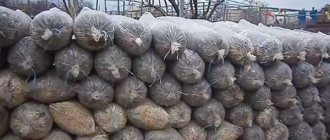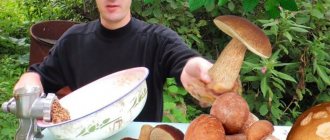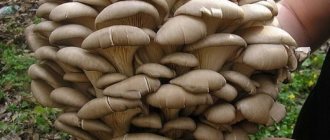Mushrooms are a delicacy that people go on a “quiet hunt” for. Experienced mushroom pickers carefully hide the places where they get them. And they are not cheap on sale. But you can get this food product even at home, since growing mushrooms in their dachas .
Mushrooms are even collected in the countryside
Why I decided to try growing mushrooms in the country
I have tried growing both cultivated and wild mushrooms. Not all experiments ended successfully - some did not take root, some turned out to be completely tasteless. Not without pests and diseases. But such difficulties only helped me gain a lot of experience in growing mushrooms in the country. Now I have a stable annual harvest, and on the table are marinated, fried, stewed, baked mushroom delicacies of “personal production.” I will share my experience and little secrets with you.
What mushrooms can you grow in your dacha?
It would be a misconception to think that only champignons and oyster mushrooms are suitable for garden cultivation. A variety of mushrooms can be successfully grown on the site:
- White. These forest dwellers are superior in taste to all their brothers. The number of ways to prepare them is also great: stewing, frying, pickling, salting, drying. They are bred with mycelium, mycelium and special “mushroom seedlings” (spores).
- Boletuses. These forest mushrooms live in the same way as porcini mushrooms - only under symbiont trees. You can transfer mycelium to the garden, plant “seedlings” or buy mycelium.
- Boletus mushrooms, boletus mushrooms, honey mushrooms. It can be propagated in the same ways - through mycelium, spores (soaking “seedlings”) and forest mycelium.
- Morels. Spring mushrooms that will delight you with an early harvest.
- Oyster mushrooms, champignons. Cultivated mushrooms whose mycelium is very easy to find on sale.
Having decided on the desired mushrooms, we move on to other important issues.
Using mushroom boxes (ready-made sets)
Ready-made mushroom boxes are used for growing mushrooms on a substrate.
The best option for beginners, which has its advantages and disadvantages .
pros
- ease of use - no need to spend money on insulation, water supply, electricity, etc.;
- lack of odor - ready-made myceliums do not emit a strong odor, according to reviews;
- miniature;
- the harvest can be obtained in just a few weeks;
- environmental friendliness.
Minuses
- low availability – it is quite difficult to find mushroom boxes on the market or in stores; you can only buy them in specialized online stores;
- small harvest volumes - there will be few fruits;
- cost – such myceliums are usually not cheap.
Expert opinion
Evgeny Shekhov
Mushroom picker with 12 years of experience, lives in the capital. For a long time now, he and his wife have not missed a single silent hunting season.
The kits include a substrate and a special composition, safe and environmentally friendly, for germinating mushrooms at home.
Mushroom boxes are easy to use, which is why they are ideal for beginners.
Video - How to use mushroom boxes
Video - Review of home mycelium
When to plant mushrooms in the country
There are no clear dates for planting mycelium and mycelium - I breed them in the summer and early autumn, from May to October. You won’t be able to find mycelium in the forest at other times of the year. It is important to place it in soil that has already been warmed by the sun (at least to 15 C). Planting “before winter” is not suitable - the young mycelium will not withstand the cold.
You should not grow mushrooms on a sunny, hot day, or during dry weeks - your work will be in vain. I “root” the mycelium after a good rain - the ground should be well moistened, but not swampy. I choose a cool, cloudy and windless day. If the weather is sunny, I plan to plant in the evening - after sunset.
Where to plant mushrooms in the country
When choosing a place on a site for a specific variety, I make sure to study the conditions of its natural growth. If it grows under a birch tree, I make a plantation under the tree. If it prefers light partial shade in the forest, I look for the same area in the garden.
I’ll tell you about the general requirements for the place of growth:
- They prefer light, airy and fertile soil - it is best to get a real forest substrate for them and renew it as it becomes depleted.
- Symbiont mushrooms are planted only under those plants with which they “cooperate.”
- The mycelium and mycelium are placed as close as possible to the roots of the symbiont - so that it quickly wraps around the root system, from which it will receive nutrition. The recommended distance from the tree trunk is at least 50 cm.
- Forest mushrooms “don’t like” fruit trees. Therefore, if you add them to an apple or pear tree, nothing will work.
The best option is to imitate a forest clearing in the garden. To do this, the top layer of garden soil under the trees is cut off by about 30 cm. It is replaced with forest substrate. This soil mixture does not need to be fertilized - only moistened during dry periods and systematically updated. I also don’t forget to collect natural mulch from the forest in the spring - leaves that have rotted over the winter. Its layer will reliably protect the “plot” from drying out.
boletus
The boletus grows only under a living tree, as it feeds from its root with carbohydrates and amino acids, giving it in return moisture and mineral compounds, natural antibiotics and protection from pests. The growing methods are completely identical to boletus. Reproduction methods: spores, fruiting bodies, mycelium transplantation.
Boletus, boletus and boletus got their names for a reason. They grow only under forest deciduous trees. They cannot form a useful symbiosis with garden fruit crops and therefore will not grow.
How to obtain material for sowing
With mushrooms it is somewhat easier than with growing garden plants - I obtained “seed material” in three different ways:
- Controversy. Fungi reproduce using spores - they can be called distant ancestors of the seeds of flowering plants. The spores are located in the sponge of the cap - it is impossible to collect them manually, they are so microscopic. Therefore, I turn the caps of the required mushroom into pulp - this is how a kind of “seedling” turns out.
- Mycelium. One of the most difficult materials to obtain - I went into the forest, looked for the fruiting bodies of the mushrooms I needed, dug them out along with the mycelium. But, as practice has shown, forest dwellers take root more easily in the garden if you use this method.
- Mycelium. The simplest, but already paid method. Mycelium of the variety of mushrooms you need can be purchased at a large garden center or ordered online from reliable suppliers.
The choice of one or another “seed” depends on the type of mushrooms that you want to grow.
growing champignons from mycelium
What is mycelium?
Mycelium reproduces by mycelium. This is a vegetative body containing fungal cells, which is a plexus of fibers - hyphae. They are so thin that 1 gram of forest litter can contain up to 35 km of these fibers. The hyphae form a fluff, resembling cotton wool, white, sometimes with a yellowish tint, and brown. If you create favorable conditions for this tissue, mushrooms will soon appear from it.
Reference. Myceliums die over time. Life expectancy depends on the type of organism: for some it is only a year, for others it is decades.
The mycelium usually grows in the form of rays emanating from the center. Fruiting bodies are formed at the other end of the ray. This is how a conditional circle is formed, which is called a witch’s ring. The older the mycelium, the larger its radius, sometimes reaching 20–22 meters.
Witch's ring
Soil preparation
The key to successful engraftment of the “seed material” is a properly prepared soil mixture. I’ll tell you about the most suitable substrates for mushrooms.
Straw
This material can be used both as a mushroom substrate and as mulch. But mushrooms will not grow in straw alone - it must be mixed either with forest litter or with rotten organic residues collected from the garden.
A fertile substrate for champignons is also prepared on the basis of straw:
- 50 kg of last year’s manure - horse, cow;
- 15-20 kg of straw;
- 12 kg of gypsum;
- 12 kg of lime.
I put all the ingredients in a pile - I also add organic waste to it. It is important to compact the mass thoroughly, pour water on it and wrap it in film. The heap matures in 15-20 days. I can judge its readiness by the strong smell of ammonia.
Logs
I'll tell you about how I grow mushrooms on a log:
- I take only healthy wood - I soak it in water for 2-3 days.
- Then I move it to a warm and dry place - either in a heated garage, or on a tarp in the sun. I wait for the excess moisture to evaporate.
- I cut out small holes in a checkerboard pattern of 10x10 cm - 4 cm deep, 0.5-1 cm in diameter.
- I place the seed in them and wrap the log in film. I make several holes in the polyethylene for air access.
- I transfer it to a warm (10-20 C) and humid room: for 2-3 months the log will be wrapped in mycelium - a thin white cobweb.
- In a place protected from the wind, in partial shade, I make a hole for the log - I bury it vertically to 30-50% of its length. To disinfect, I sprinkle the soil around with ash. I “plant” the log as soon as the air temperature rises to 15-25 C.
- In dry weather, I water the soil around the log once every 2-3 weeks.
I don’t dig up a log with mycelium in the fall - I insulate it for the winter with compost and rotten leaves.
growing oyster mushrooms on stumps
Sawdust
A popular type of soil mixture for mushrooms is based on sawdust. You can mix them in equal parts with compost, garden soil, and rotted plant debris. Be sure to treat the mass with disinfectant suspensions - potassium permanganate, copper sulfate, boric acid. It wouldn’t hurt to spill it with a solution of a growth stimulator.
Other substrates
I consider the best option for mushrooms to be forest litter or its imitation:
- rotted foliage, pine needles;
- wood dust;
- rotten moss.
Some of the elements can be replaced with last year's garden compost. Wood ash will be a fertilizer and disinfectant for the substrate.
Seedling
There is another way to grow porcini mushroom in your area. You need to bring the caps of this plant from the forest. They are finely chopped or grated. You can pass the prepared material through a meat grinder.
The gruel is poured with water and left for a day. Now you need to choose the right place for planting the prepared material.
The soil under the selected tree needs to be dug up. Compost is added here. When the pulp is infused in water, it is poured onto the prepared soil. This place is covered with leaves.
These simple tips will help you grow your favorite varieties of mushrooms. If there are several trees on the site, you can grow a real mushroom clearing. It will be a pleasure to relax here. If desired, you can grow them in a greenhouse or suitable room. Mushrooms can be collected all year round for yourself or even for sale.
Subscribe to our Telegram channelExclusive posts every week
Features of growing some types of mushrooms in the country
Keep in mind that forest animals are symbionts by nature. For life, development and formation of fruiting bodies, they need a continuous exchange of substances with the bodies of higher plants. In most cases - with their roots. Each forest mushroom has its own symbiont. The boletus has birch, the porcini mushroom has coniferous trees, and the boletus has aspen.
Accordingly, there should be a tree on your site that will allow the fungus to develop. Without this condition, the mycelium and mycelium will die without nutrition. Don't think that mushrooms will harm trees - they are not parasites. Symbiotic coexistence is equally beneficial for both the plant and the fungi.
I’ll tell you about the features of growing some mushrooms:
- White. They take root next to a pine tree - it must be a mature tree at least 30 years old. The best type of breeding is through forest mycelium. A big mistake is to plant them next to fruit trees.
- Boletuses. If you decide to engage in spore breeding, then you should cut off the pulp under the cap of the overripe one. Soak the mass in dechlorinated warm water for a day, and then bury it in the ground according to my advice.
- Butter, honey mushrooms. If most forest mushrooms need a living, healthy tree-symbiont, then these require rotten, almost collapsed stumps for development. Having uprooted such “wealth” from the forest, you can grow delicious garden mushrooms on it with great success. Another option is to carefully cut off the bark sprinkled with honey mushrooms from the stump. It is more convenient to use a saw or hacksaw. The “Mushroom Kingdom” can be planted in the shade of trees, covered with mosses, and then supplied with the necessary nutrition - wood dust.
- Morels. Spring mushrooms, ready for April-May. At this time, you need to go to the forest to collect fruiting bodies and mycelium. Morels do not like the proximity of fruit trees, especially apple trees.
- Champignon. These are the mushrooms that do not require symbiont trees on the site. On the contrary, they tolerate proximity to any higher plants, including fruit and fruit plants. They are grown on a special substrate with straw. They love champignons and manure, compost heaps rich in organic matter. Prefer good moisture and shade.
- Oyster mushrooms, shiitake. They grow on trees, including dead ones. Therefore, you can grow them on rotten stumps and logs using the method that I described above. Oyster mushrooms are the most productive of cultivated mushrooms. The mycelium does not survive frosty winters - harvesting from one plantation can take several years.
I advise you to start with cultivated mushrooms, whose mycelium, along with detailed growing instructions, can be found in garden centers. As soon as this works out, you can start experimenting with forest ones.
Methods for growing mushrooms in the country
I will tell you about the most common methods of relocating to your site.
Propagation by spores
I prefer to use this method as a backup, safety net. For example, if I bring mycelium from the forest, I don’t forget to “sow” spores in the neighborhood. The method for preparing “mushroom seedlings” is very simple:
- I separate the mushroom caps, finely chop them with a knife or pass them through a meat grinder.
- I fill it with dechlorinated water (rain is best) and let it sit for a day.
- About 0.5 m from the tree trunk, I dig a hole 25-30 cm deep. Best of all is the one under which they grew in their natural environment.
- I pour the “seedlings” into the hole, cover it with forest substrate - rotted leaves, wood dust.
- For the first 1-2 weeks I don’t touch the “planting” at all. Then I begin to water the breeding site with water using the sprinkling method.
This breeding method is waste-free. If after a trip to the forest you still have trimmings of spoiled mushroom caps, do not rush to throw them away. Prepare “mushroom seedlings” according to my recipe. If it doesn’t take root, there’s nothing to worry about – you’ll add useful fertilizer to the soil.
For “seedlings” of mushrooms, overripe caps are best suited - they will contain ready-made spores. There is nothing to worry about if they are wormy - when soaked, the pests will emerge. It is best to place the mushroom mass in heated and dechlorinated water.
A little secret: you need to start a process similar to the fermentation process in the stomach of a forest animal that feeds on mushrooms - it is this that “revives” the spores. To do this, I add a couple of spoons of sugar, dry yeast or leaven and start fermentation. During soaking, do not forget to stir the mixture with a spoon.
Growing mycelium
I have already written that breeding mycelium is the most difficult, time-consuming, but also the most reliable method. I'll tell you step by step how I implement it:
- 1-2 weeks before collecting the mycelium, I prepare the substrate - I mix last year’s compost, rotted leaves and dust from an old stump in approximately equal parts.
- When going to the forest, I always take a bag filled with this soil mixture, a bottle of water, and a bayonet-shovel (I don’t forget to sharpen it well).
- I look for the variety I need by the type of fruiting bodies. If you are not an experienced mushroom picker, then first study the reference book and find the necessary images on the Internet so as not to move inedible or even poisonous mushrooms onto your plot.
- Using a bayonet-shovel, I remove the forest substrate 10-15 cm in diameter from the fruiting body until I reach the mycelium, which resembles a cobweb. It often gets intertwined with plant roots, so you have to carefully cut them off (that's why I sharpen the shovel).
- I take the mycelium along with a large lump of native substrate and place it in a bag with prepared soil mixture. It is important that it is poured in a deep layer.
- I moisten the mixture a little with water from a bottle.
- Then my task is to bring the mycelium to the garden as quickly as possible.
Mushrooms love the same substrates as in their native forest. In most cases - light, breathable, drained. But not over-moistened, caked, or heavy. Having decided on the landing site, I proceed as follows:
- At a distance of 40-60 from the trunk of the symbiont tree, I remove the top layer of soil (25-30 cm).
- I fill the bottom of the hole with a mixture of humus, plant residues, and wood dust.
- I carefully place the mycelium on this bedding.
- I sprinkle it with the same layer of rotted leaves, dust and humus.
- I lightly moisten the planting site.
If the mycelium has taken root, you will notice the first signs of life within 2-3 weeks.
Growing mycelium in the garden
This method is the most professional of those listed. It is impossible not to note its simplicity, as well as the high probability of mycelium engraftment. The latter is divided into two types:
- Grain. For planting, the mass is mixed with compost or garden substrate.
- Compost. Fill with water, stir until the consistency of sour cream, and then plant.
I recommend proceeding with your purchase according to the following instructions:
- Buy mycelium on a specialized website or at a gardening store. Carefully study the annotation to it - whether the “seed material” is suitable for your region and the type of soil on the site. Here I prefer not to save money - I buy a little more mycelium than I need.
- Before planting, I store the mixture in the refrigerator. Before the “sowing” itself, I test its viability - I move it to a warm place for 3-4 days. If it is active, it begins to grow and smell like mushrooms. If not, it will not show signs of life and will be enveloped in a sour smell.
- I choose a place for planting - in partial shade, on the roots of trees. I remove the top layer of the substrate by 30-40 cm. At the same time, I retreat from the tree trunk by about half a meter. The area of the recess depends on the volume of purchased mycelium.
- At the bottom of the hole I place a mixture of humus, tree dust, sawdust and ash (15 cm). Then - a thin layer of fertile black soil.
- I place the mycelium on the mat, distribute it, and smooth it with my hands. For better engraftment, it even needs to be compacted into the ground a little.
- I cover it with the same soil mixture, a layer of rotten leaves, and lightly water it.
The mycelium does not require special care in the future - only watering (by sprinkling) every 2-3 weeks. If the summer is rainy, then additional water procedures are not required.
Caring for mushrooms in the country
They do not require the same care as cultivated flowering plants. Our task is to bring the conditions of their existence in the garden as close as possible to natural, forest ones. I do this in the following ways:
- Watering. Since childhood, we have known the saying “We grew up like mushrooms after the rain.” But this does not mean that mushrooms love waterlogged soil. They feel comfortable only in a moderately moist substrate - that’s why we never look for them in a swampy forest. I water them by sprinkling only when the soil mixture dries out. I try to use natural water - melt, rain, well.
- Fertilizers. Under natural conditions, fungi get enough nutrition from the roots of their symbionts. In the garden, periodic fertilizing with compost, ash, and organic residues will not harm them - I simply scatter dry fertilizers over the mushroom plantation and then water it.
- Growth stimulants. Mushrooms respond well to humates, Epin, Zircon. Therefore, in the spring, in order to awaken the mycelium, I water it with solutions of growth activators.
To preserve the mycelium for next year, I don’t forget to insulate it in the fall with a “cap” of rotten leaves or plant remains. If the winter is expected to be cold, I additionally cover it with a piece of slate, linoleum, or roofing felt. In the winter months I insulate it with a snow “pillow”.
If the mycelium survives the winter, you will not need to buy mycelium or breed “seedlings” - the harvest will “ripen” for several years in a row. The mycelium is a living organism: in comfortable conditions it grows and is gradually replaced by a younger one.
Harvesting
Depending on the timing of planting, the harvest of country mushrooms occurs in spring or autumn. The ripening of the crop occurs in waves, so you need to visit the mushroom bed every week. When harvesting, you should adhere to the following rules:
- Each mushroom is cut at the root of the stem with a sharp knife so as not to damage the mycelium.
- The sections should be mulched with compost to prevent the mycelium from drying out.
- After each harvest, the mushroom plantation should be watered with a watering can to activate further growth of the crop.
- If the mushrooms are overripe, it is better to use them for spore propagation.
Rules for harvesting champignons
Harvesting dates for different types of mushrooms:
- Champignon . The first harvest is ready for harvest 30-40 days after the mycelium is laid, subsequent ones - every 5-10 days.
- Honey mushrooms . The harvest is harvested twice a year - in spring and autumn.
- Boletuses appear at the end of summer.
- Chanterelles . Fruiting begins in June-July.
- Porcini . The harvest is harvested in spring or autumn, depending on the planting date and weather conditions.
What difficulties may arise when growing mushrooms in the country?
Mushrooms, like plants, suffer from diseases and pests. Moreover, in unnatural conditions, gardens become more susceptible to viruses and bacteria.
Pest Control
In addition to the well-known worms that spoil the fruiting bodies of mushrooms, there are other enemies:
- Fungus gnat. This pest gnaws holes in the fruiting body of the fungus and lays larvae there. To protect my plantations from it, I periodically treat them with insecticides. Another way to combat this is to buy a small mosquito net and cover the mushroom “beds” with it. If the insect has already attacked the fruiting body, all that remains is to destroy it.
- Fungus mite. It can appear on a mushroom plantation when fertilized with fresh manure. The pest gnaws passages and tunnels in the fruiting body, making it inedible. Such a spoiled harvest can only be thrown away. Prevention of ticks - treating the soil mixture with acaricides, calcining the soil at high temperatures.
If you use acaricides or insecticides, carefully read the instructions for the preparations. Not everything that is used for cultivated plants is applicable to fungi. Be sure to consult with the seller about the possibility of using the product and the required waiting period.
fungus gnat
Disease Prevention
Here are the common fungal diseases:
- Carmine mold. One of the most common fungal diseases. First, individual white threads appear on the cap, and then a whole edge appears. As the disease develops, the color changes from snow-white to cherry. There is no treatment for the disease - the fruiting bodies are cut off and the mycelium is dug out. The place where it is sowed is treated with a 1% solution of copper sulfate and potassium permanganate. To prevent this problem from damaging the next harvest, carefully follow the watering schedule and do not overfeed the mushrooms with nitrogen-containing substances.
- Mycogonosis (white rot). A consequence of improper watering and inappropriate temperature conditions. The infected mushrooms themselves cannot be saved - the fruiting bodies are cut off, and the mycelium site is spilled with a strong (raspberry) manganese solution. If you grew mushrooms indoors, do not enter it without a respirator - inhaling spores is dangerous for humans. Be sure to treat the barn, cellar or garage with chemicals against mycogonosis.
- Rusty spotting. A consequence of an incorrect hydration schedule. If you notice strange rusty spots on the fruiting bodies, remove them as soon as possible. Spray the mushroom plantation with a disinfectant solution of potassium permanganate, treat uninfected fruiting bodies - both caps and stems - with this suspension.
- False truffle disease. The mycelium of cultivated mushrooms is affected by the mycelium of the false truffle. Such a parasitic neighborhood gradually leads to its death. It is impossible to save the mycelium - all that remains is to destroy it. Therefore, before sowing, I always treat the soil mixture - I spill it with iodine (a few drops) or manganese (a few crystals) solution. Another disinfection option is a 1% solution of copper sulfate. Chernozem can also be calcined in the oven or microwave.
Now you know all the intricacies of growing forest, cultivated mushrooms in a regular summer cottage. They do not require care like flowering plants - you just need to create conditions close to natural. The biggest difficulty is the engraftment of the mycelium, mycelium. If it was successful, most of the matter is over. All that remains is to monitor the moisture content of the plantation and prevent diseases and pests.
Pests and diseases
Most often, parasites infect the fruiting body; one of their sources can be poor-quality compost. To reduce the risk of gypsum mold infection, experienced gardeners recommend setting aside a separate set of tools for mushrooms.
Dung beetles, also called ink mushrooms, interfere with the development of oyster mushrooms and champignons; they grow quickly in a moist substrate or when it contains excess nitrogen. The only way to combat this pest is to remove it from the beds manually.
Champignons are vulnerable to brown gypsum; it occurs due to insufficient air exchange, high humidity, and is manifested by a sweetish odor and white spots on the soil substrate (the latter become brown after the formation of spores). As preventive measures, you need to monitor the humidity level of the substrate, pollinate it with gypsum, and avoid air stagnation.
Typical diseases of the mushroom “plantation” at the dacha are trichoderma, dry rot, white rot, bacterial and rust spot. Rodents, mosquitoes, fungus flies, and ticks can damage the crop.
